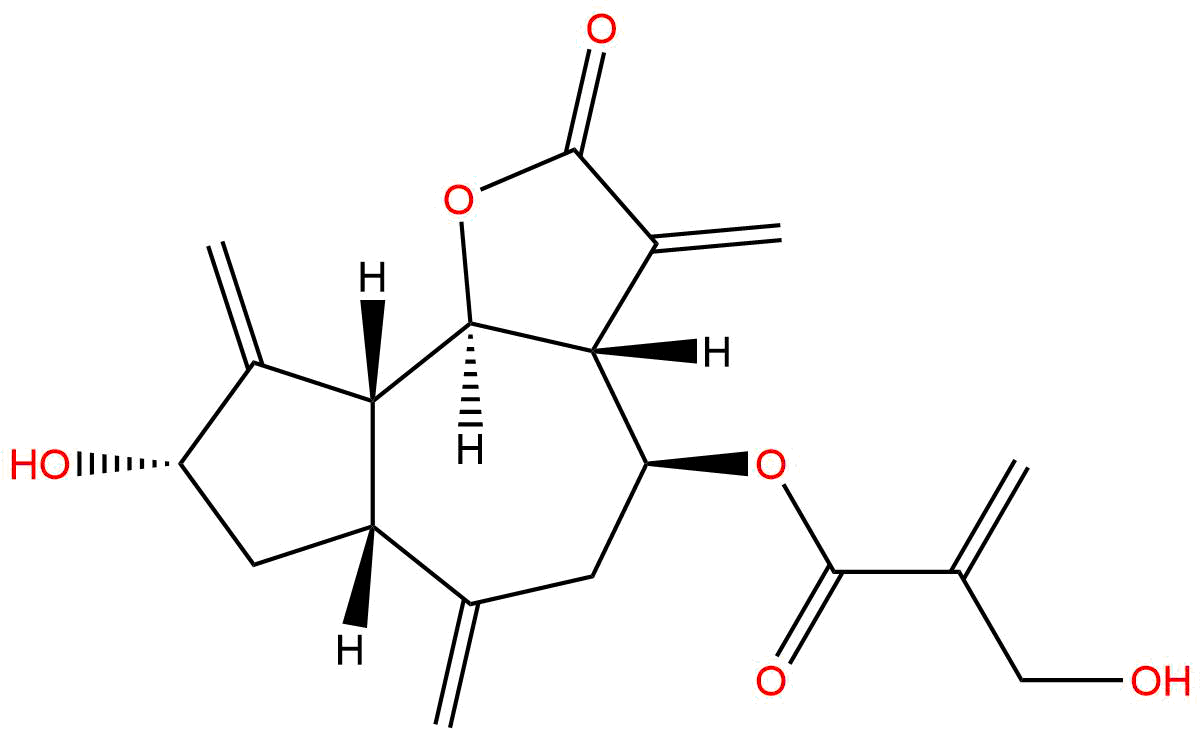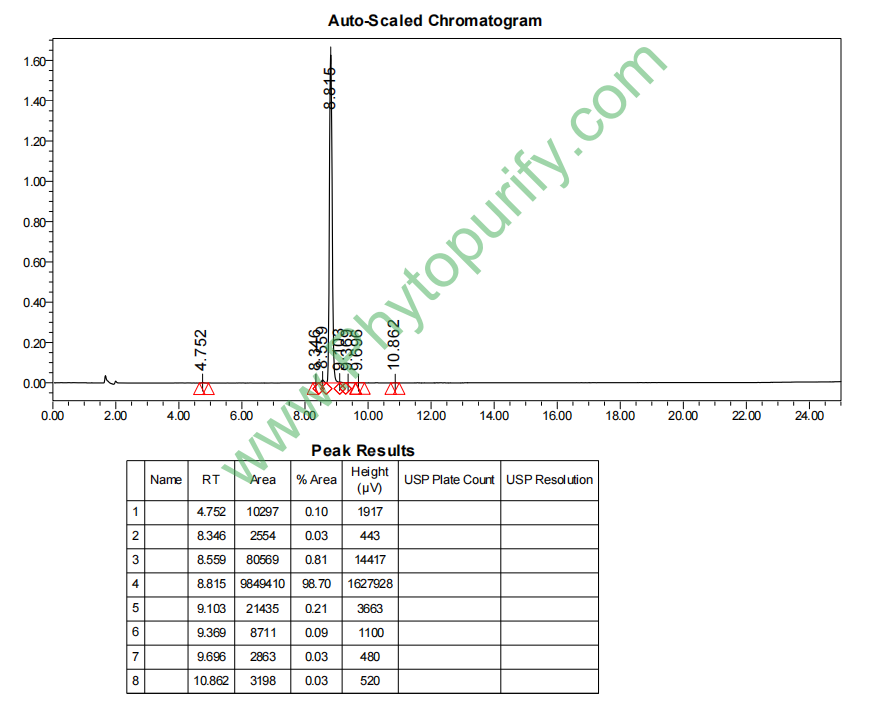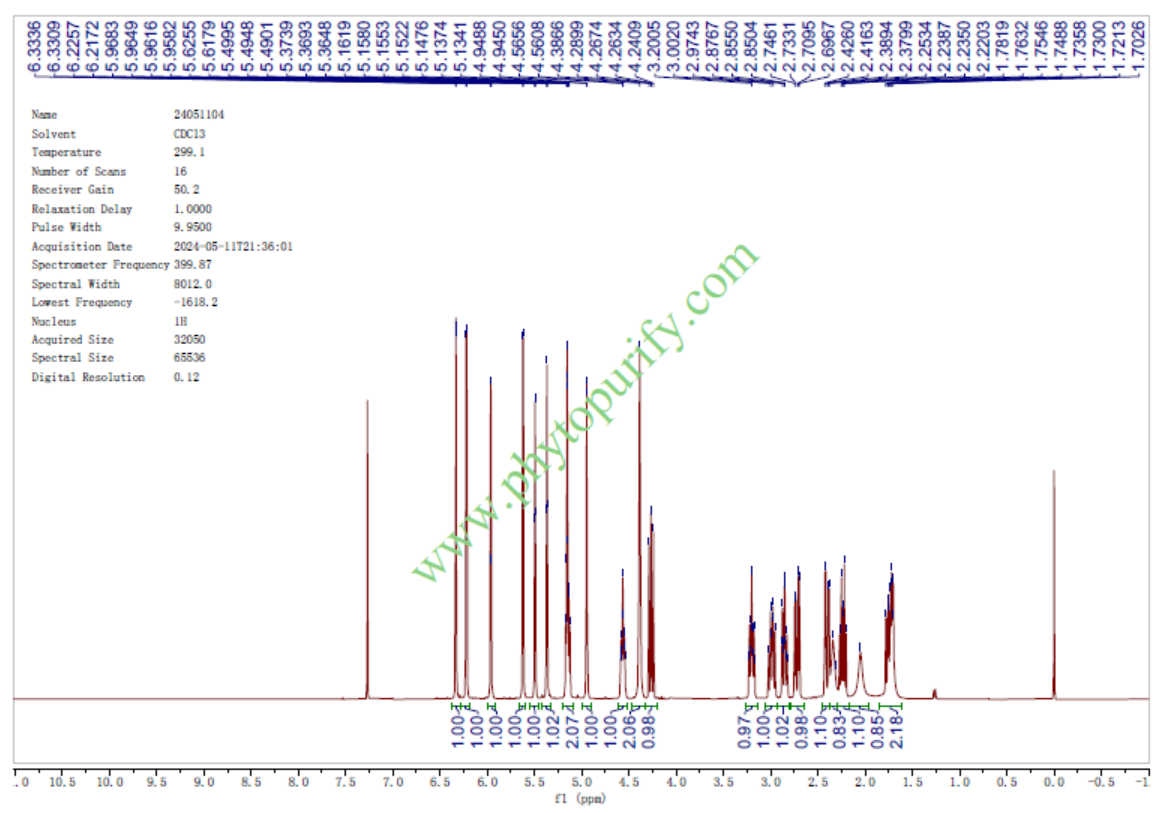
CynaropicrinCAS No.:35730-78-0
|
||||||||||
 |
|
|
||||||||

| Catalogue No.: | BP0443 |
| Formula: | C19H22O6 |
| Mol Weight: | 346.379 |
Synonym name:
Catalogue No.: BP0443
Cas No.: 35730-78-0
Formula: C19H22O6
Mol Weight: 346.379
Botanical Source: Cynara scolymus, Centaurea canariensis, Amberboa ramosa, Grossheimia macrocephala, Tricholepis glaberrima and others
Purity: 95%~99%
Analysis Method: HPLC-DAD or/and HPLC-ELSD
Identification Method: Mass, NMR
Packing: Brown vial or HDPE plastic bottle
Can be supplied from milligrams to grams.
For Reference Standard and R&D, Not for Human Use Directly.
Inquire for bulk scale.
Description:
Cynaropicrin is a potent activator of the AhR-Nrf2-Nqo1 pathway, and could therefore be applied to prevention of UVB-induced photo aging; it may be a potential anticancer agent against some leukocyte cancer cells such as lymphoma or leukemia, through pro-apoptotic activity. Cynaropicrin shows in vivo activity against Trypanosoma brucei. Cynaropicrin possesses immunomodulatory effects on cytokine release, nitric oxide production and immunosuppressive effects. Cynaropicrin also has anti-inflammatory effects, it may participate in the inflammatory response by inhibiting the production of inflammatory mediators and the proliferation of lymphocytes and its inhibitory effect is mediated through conjugation with sulphydryl groups of target protein(s).
References:
Eur J Pharmacol. 2000 Jun 23;398(3):399-407.
In vitro anti-inflammatory effects of cynaropicrin, a sesquiterpene lactone, from Saussurea lappa.
We investigated in vitro anti-inflammatory effects of Cynaropicrin, a sesquiterpene lactone from Saussurea lappa, on tumor necrosis factor (TNF)-alpha and nitric oxide (NO) release, and lymphocyte proliferation.
METHODS AND RESULTS:
Cynaropicrin strongly inhibited TNF-alpha release from lipopolysaccharide-stimulated murine macrophage, RAW264.7 cells, and differentiated human macrophage, U937 cells, proved to produce notable amount of TNF-alpha. It also potently attenuated the accumulation of NO released from lipopolysaccharide- and interferon-gamma-stimulated RAW264.7 cells in a dose-dependent manner. In addition, the immunosuppressive effects of the compound on lymphocyte proliferation in response to mitogenic stimuli were examined. Cynaropicrin also dose-dependently suppressed the proliferation of lymphocytes from splenocytes and interleukin-2-sensitive cytotoxic T lymphocyte, CTLL-2 cells, stimulated by lipopolysaccharide, concanavalin A, phytohemagglutinin and interleukin-2. However, treatment with sulphydryl compound, L-cysteine, abrogated all these inhibitory effects.
CONCLUSIONS:
These results suggest that Cynaropicrin may participate in the inflammatory response by inhibiting the production of inflammatory mediators and the proliferation of lymphocytes and its inhibitory effect is mediated through conjugation with sulphydryl groups of target protein(s).
Planta Med. 2012 Apr;78(6):553-6.
Cynaropicrin: the first plant natural product with in vivo activity against Trypanosoma brucei.
A screen of 1800 plant and fungal extracts with subsequent HPLC-based activity profiling was done to identify new antiprotozoal leads from nature.
METHODS AND RESULTS:
This led to the identification of Cynaropicrin (1) from the herb CENTAUREA SALMANTICA L. (Asteraceae) as a potent IN VITRO inhibitor of TRYPANOSOMA BRUCEI RHODESIENSE. It preferentially inhibited T. B. RHODESIENSE (IC (50) of 0.3 μM) and T. BRUCEI GAMBIENSE (IC (50) of 0.2 μM), compared to TRYPANOSOMA CRUZI (IC (50) of 4.4 μM) and PLASMODIUM FALCIPARUM (IC (50) of 3.0 μM). Testing against melarsoprol- and pentamidine-resistant strains (IC (50)s of 0.3 μM and 0.1 μM, respectively) showed no cross-resistance. Intraperitoneal administration of 2 × 10 mg/kg body weight/day in the T. B. RHODESIENSE STIB 900 acute mouse model led to a 92 % reduction of parasitemia compared to untreated controls on day seven post-infection. Removal of the 2-hydroxymethyl-2-propenoyl moiety of Cynaropicrin led to a loss of toxicity towards T. B. RHODESIENSE. Cytotoxicities against rat myoblasts (L6 cells), human colon adenocarcinoma cells, and murine peritoneal macrophages were measured, and selectivity indices of 7.8, 62, and 9.5 were determined.
CONCLUSIONS:
This is the first report of a plant natural product with potent IN VIVO activity against TRYPANOSOMA BRUCEI.
HPLC of Cynaropicrin

HNMR of Cynaropicrin
